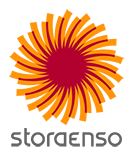How does the Consumer Board division fit in the Stora Enso strategy?
Stora Enso continues its transformation to be the global renewable materials growth company. The Consumer Board division supports as a growing business in renewable packaging. Today many end-consumers are asking for products with better sustainability footprints. For us, this means focusing our innovation efforts on creating solutions to allow our customers to replace fossil-based materials, such as plastics, with renewable ones.
In line with Stora Enso’s strategy for sustainable profitable growth, Consumer Board division aims to be the preferred partner in premium end-use packaging segments, maintaining a strong market position in Europe, capturing the market opportunities in China and growing selectively in other overseas markets. Our targets are to reach commercial and operational excellence as well as customer centric innovations, product management and service through a developed supply chain strategy.
The Beihai Mill started up in May 2016. The focus has been to quickly introduce products in the market and meet qualifications for products and all the main grades. The mill is well-designed and the board machine can exceed the designed capacity without additional investments. The Polyethylene (PE) coating plant will be inaugurated in December this year. The target is to reach EBITDA breakeven during Q4 2017, and the board machine is expected to reach full production during the first half of 2018.
What are the division’s opportunities?
We are the global leader in our focus segments, and have well-developed ecosystems of partners and customers throughout our value chain. With our innovation centre, we can support the ambitions of our customers and brand owners and co-create together. Our assets are strong and positioned for growth. For instance, with our latest investment in the plantation-based board mill in Beihai, we can leverage the growing market in China and South East Asia. Our people have extensive knowledge and access to a broad network for collaborations, such as with start-ups focusing on new materials. And, of course, access to renewable raw material through our certified forests and plantations is an opportunity.What will define the future of packaging?
Many factors point towards renewability and recyclability. Customers and brand owners are committing to ambitious sustainability targets that are transparent and can be publicly followed up, to strengthen their corporate and brand value. In many markets, legislation is driving policies for greater sustainability and responsibility. Empowered consumers want to be assured of the origin of what they consume. They care for food safety and product authenticity. They want to buy from companies that show social, environmental and ethical responsibility all along the value chain. All that said, functionality, interactivity, design and other criteria for the optimal consumer experience remain strong differentiators in the fight for market share. Packaging matters in driving sales, and understanding consumer behaviour is key to our future success.
What is the division doing in terms of innovation?
Our starting point is customer need and consumer preferences, and there are many opportunities for innovation. We have made good progress in several of our innovation programmes during the past year. One area, were we are the industry leader, is micro-fibrillated cellulose (MFC). This brings great advantages in packaging for source reduction and lightweighting, i.e. using less fibre resources while still maintaining strength properties, and can support different barrier properties such as moisture resistance. Future developments in the area of paperboard packaging and MFC include renewable barrier films for grease and oxygen, as well as transparent films and biodegradable substitutes for aluminium film. With investments in MFC in three of our mills, we are moving from pilot to industrial scale. As a first step, MFC is being commercialised in the liquid packaging segment and more applications will follow.
We have launched several new products responding to customer needs, e.g. a new upgraded version of Ensocoat for the luxury packaging segment as well as a new unbleached naturally brown board called Natura Life (LPB). The interest in our intelligent packaging solutions continues to be high. These can support brand and retail strategies by enhancing consumer engagement through the packaging, increasing efficiency and transparency in the supply chain, and assuring safety throughout a product’s route from production to consumer.
Overall, digitalisation also gives us the power to optimise operations and logistics.
What is the role of Consumer Board division in the bioeconomy?
The bioeconomy is needed to solve some of society’s modern challenges: using resources more efficiently and thus alleviating the pressure on the environment while also meeting increasing consumption. Every day, billions of goods are purchased and transported in one way or another – the common denominator is that they all need a package. We can contribute through replacement of fossil-based materials in packaging solutions and by making sure the packaging is fit for purpose. The use of renewable, recyclable and biodegradable materials as well as rightsizing the packaging to reduce resource use is no longer just a ‘nice to have’ but ‘a must’ in the bioeconomy.





